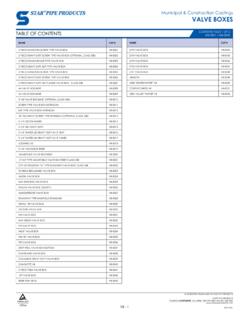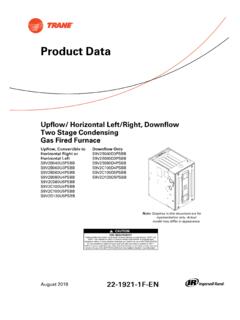Transcription of Do your Part— Be SepticSmart!
1 Do your Part . Be SepticSmart! A Homeowners'Guide to Septic Systems TM. Environmental Protection Agency A Homeowners' Guide to Septic Systems | 2. Maintaining Your Septic System: Good for your wallet. Good for your health. Good for the environment. Did you know that one-quarter of all homes have septic systems? Yours may be one of them. If you're not properly maintaining your septic system, you're not only hurting the environment, you're putting your family's health at risk and may be flushing thousands of dollars down the drain! First Things First: What Is a Septic System? Common in rural areas without centralized sewer systems, septic systems are underground wastewater treatment structures that use a combination of nature and time-tested technology to treat wastewater from household plumbing produced by bathrooms, kitchen drains, and laundry.
2 Do You Have a Septic System? You may already know you have a septic system. If you don't know, here are tell-tale signs that you probably do: You use well water. The waterline coming into your home doesn't have a meter. You show a $ Sewer Amount Charged on your water bill. Your neighbors have a septic system. A Homeowners' Guide to Septic Systems | 3. How To Find Your Septic System Once you've determined that you have a septic system, you can find it by: Looking on your home's as built drawing. Checking your yard for lids and manhole covers. Contacting a septic inspector/pumper to help you locate it. Why Should You Maintain Your Septic System? Maintaining Your Septic System.
3 Saves You Money Regular maintenance fees of $250 to $300 every three to four years is a bargain compared to the cost of repairing or replacing a malfunctioning system, which can cost between $3,000 and $7,000. The frequency of pumping required for your system depends on how many people live in your home and the size of the system. Protects Your Property Value An unusable septic system or one in disrepair will lower your property value, not to mention pose a potentially costly legal liability. Keeps You and Your Neighbors Healthy Household wastewater is loaded with disease-causing bacteria and viruses, as well as high levels of nitrogen and phosphorus.
4 If a septic system is well-maintained and working properly, it will remove most of these pollutants. Insufficiently treated sewage from septic systems can cause groundwater contamination, which can spread disease in humans and animals. Improperly treated sewage also poses the risk of contaminating nearby surface waters, significantly increasing the chance of swimmers contracting a variety of infectious diseases, from eye and ear infections to acute gastrointestinal illness and hepatitis. Service provider coming? Here's what you need to know. When you call a septic service provider, he or she will inspect for leaks and examine the scum and sludge layers in your septic tank.
5 Your septic tank includes a T-shaped outlet which prevents sludge and scum from leaving the tank and traveling to the drainfield area. If the bottom of the scum layer is within six inches of the bottom of the outlet, or if the top of the sludge layer is within 12 inches of the outlet, your tank will need to be pumped. Remember to note the sludge and scum levels determined by the septic professional in your operation and maintenance records, as this will help determine how often pumping is necessary. The service provider should note any repairs completed and the tank condition in your system's service report. If additional repairs are recommended, be sure to hire someone to make them as soon as possible.
6 The National Onsite Wastewater Recycling Association (NOWRA) website has a septic locator that makes it easy to service professionals in your area. Visit and enter your ZIP. code to get started! A Homeowners' Guide to Septic Systems | 4. Beware of septic tank additives! Some makers of septic tank additives claim their products break down septic tank sludge in order to eliminate the need for pumping. But the effectiveness of additives has not been determined; in fact, many studies show that additives have no significant effects on a tank's bacterial populations. Septic tanks already contain the microbes they need for the effective breakdown of household wastewater pollutants.
7 Periodic pumping is the only true way to ensure that septic systems work properly and provide many years of service. Protects the Environment More than four billion gallons of wastewater is dispersed below the ground's surface every day. That's a lot of water! Groundwater contaminated by poorly or untreated household wastewater doesn't just pose dangers to drinking water it poses dangers to the environment. Malfunctioning septic systems release bacteria, viruses, and chemicals toxic to local waterways. When these pollutants are released into the ground, they eventually enter streams, rivers, lakes, and more, harming local ecosystems by killing native plants, fish, and shellfish.
8 Maintaining Your Septic System: The Basics Septic system maintenance isn't complicated, and it doesn't need to be expensive. Upkeep comes down to four important elements: Inspection and pumping Water efficiency Proper waste disposal Drainfield care Inspect and pump frequently The average household septic system should be inspected at least every three years by a septic service professional. Household septic tanks are typically pumped every three to five years. Alternative systems with electrical float switches, pumps, or mechanical components need to be inspected more often, generally once a year. A service contract is important since alternative systems have mechanized parts.
9 Four major factors influence the frequency of septic pumping: Household size Total wastewater generated Volume of solids in wastewater Septic tank size A Homeowners' Guide to Septic Systems | 5. Use water efficiently Did you know that average indoor water use in a typical single-family home is nearly 70 gallons per individual, per day? And just a single leaky toilet can waste as much as 200 gallons of water per day? All of the water a household sends down its pipes winds up in its septic system. This means that the more water a household conserves, the less water enters the septic system. Efficient water use can not only improve the operation of a septic system, but it can reduce the risk of failure as well.
10 Learn more about simple ways to save water and water-efficient products by visiting EPA's WaterSense Program at High-efficiency toilets: Toilet use accounts for 25 to 30 percent of household water use. Most older homes have toilets with to 5-gallon reservoirs, while newer, high-efficiency toilets use gallons of water or less per flush. Replacing existing toilets with high-efficiency models is an easy way to quickly reduce the amount of household water entering your septic system. Faucet aerators and high-efficiency showerheads: Faucet aerators help reduce water use as well as the volume of water entering your septic system. High-efficiency showerheads or shower flow restrictors also reduce water use.














